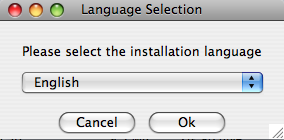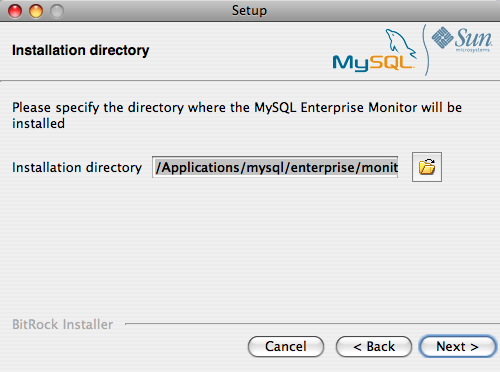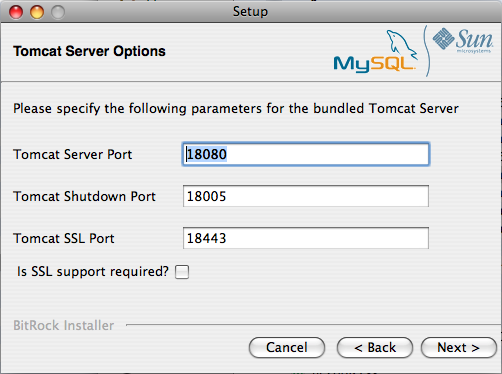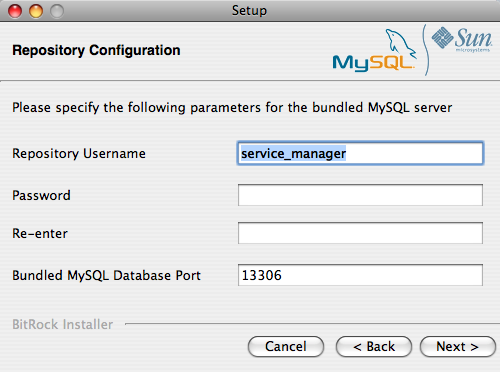- 2.2 Service Manager Installation
- 2.2.1 Service Manager Installation Common Parameters
- 2.2.2 Service Manager Installation on Windows
- 2.2.3 Service Manager Installation on Mac OS X
- 2.2.4 Service Manager Installation on Unix
- 2.2.5 Starting/Stopping the MySQL Enterprise Monitor Service on Windows
- 2.2.6 Starting/Stopping the MySQL Enterprise Monitor Service on Unix and Mac OS X
- 2.2.7 MySQL Enterprise Service Manager Configuration Settings and Advisor Installation
On Mac OS X there are three installation modes
osx, text, and
unattended. For more information on this topic
see Section 2.4, “Unattended Installation”. The
text mode installation for Mac OS X is
identical to text installation under Unix. For
text mode installation instructions see
Section 2.2.4, “Service Manager Installation on Unix”.
Installing the MySQL Enterprise Service Manager on Mac OS X requires an existing installation of Java. The minimum required version is 1.5.0_7. If this version is not installed on your machine you can download it from Apple. This version of Java requires Mac OS X version 10.4.5 as a minimum, so you may need to upgrade your operating system in order to install it.
For reasons of backwards compatibility, Mac OS X is usually
installed with multiple versions of Java. When installing in
osx mode, version 1.5.0_7 must be the default
version. Upon installation, Java 1.5.0_7 sets itself as the
default so this is usually not a problem.
If you have changed the default you can reset it or you may
install the MySQL Enterprise Service Manager in text mode,
setting the environment variables to point to the correct version
of Java. To install in text mode, find the
installbuilder file in the
Contents/MacOS directory immediately below
the
mysqlmonitor-
directory. Installing the MySQL Enterprise Service Manager in
version-osx-installer.apptext mode is identical to the procedure
described in Section 2.2.4, “Service Manager Installation on Unix” with the
minor differences noted above.
To install using the GUI (osx) installation,
follow these instructions:
-
Double click on the MySQL Monitor installer. You should be presented with the Language Selection prompt. Select the language to use for the installer and then click OK.
-
If you have multiple Java installations on your machine, you will be asked to choose which Java to use with your MySQL Enterprise Service Manager installation. Choose the Java version you want to use (1.5.0 or later is required), and click OK.
With the installation language and Java version selected, the remainder of the installation sets up the installation location and the main configuration parameters required by MySQL Enterprise Service Manager. Click Next to contintue.
-
Select the installation directory where you want the MySQL Enterprise Service Manager components installed. By default on Mac OS X the directory is
/Applications/mysql/enterprise/monitor. You click the button next to the installation directory field to select a directory using the File chooser, or type the directory manually. Click Next to continue. -
Configure the options that set the network ports used by the Tomcat server. For more information, see Section 2.2.1, “Service Manager Installation Common Parameters”. Click Next to continue.
-
Configure the repository settings, setting the user name, password and port used to communicate with the bundled MySQL server that will be used to store the information and statistics for your installation. For more information, see Section 2.2.1, “Service Manager Installation Common Parameters”. Click Next to continue.
You will be provided with information and a warning about the configuration options and how they are stored in the
configuration_report.txtfile, and it's location. Take a note of the full path to this file in case you need to look up the information later. Click Next to continue.You should now be prompted to start the installation process. Click Next to continue.
Once the installation has been completed, you will be provided with the information on how to uninstall MySQL Enterprise Service Manager. Click Next to continue.
To complete the installation and set up your MySQL Enterprise Service Manager, you will need to login to the Dashboard. You can do this automatically by checking the box on the final window before clicking Finish. This checkbox is selected by default. If you do not want to run the Dashboard at this time, uncheck the box and clock Finish.
Your installation should now be complete. To continue with the configuration of MySQL Enterprise Service Manager, see Section 2.2.7, “MySQL Enterprise Service Manager Configuration Settings and Advisor Installation”.





